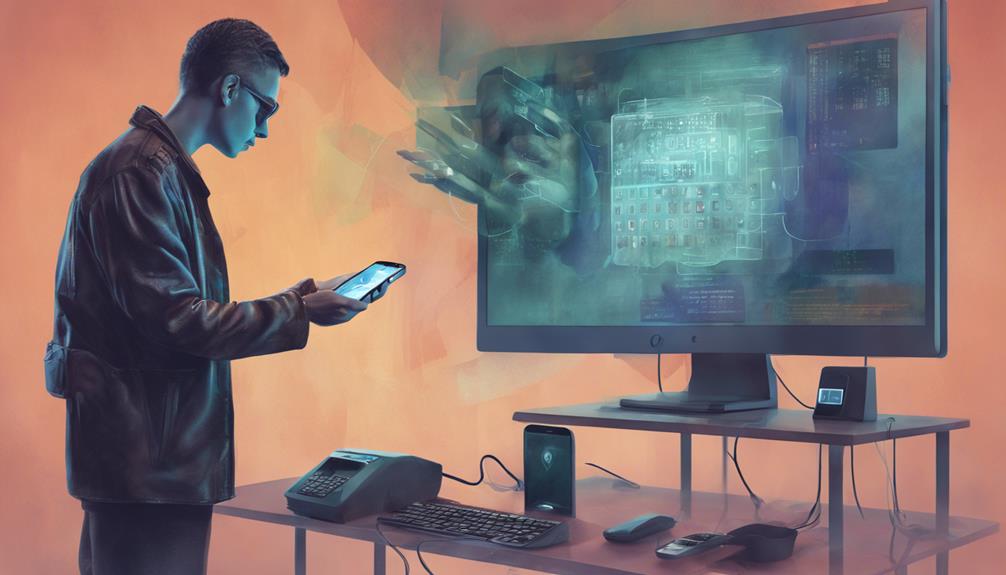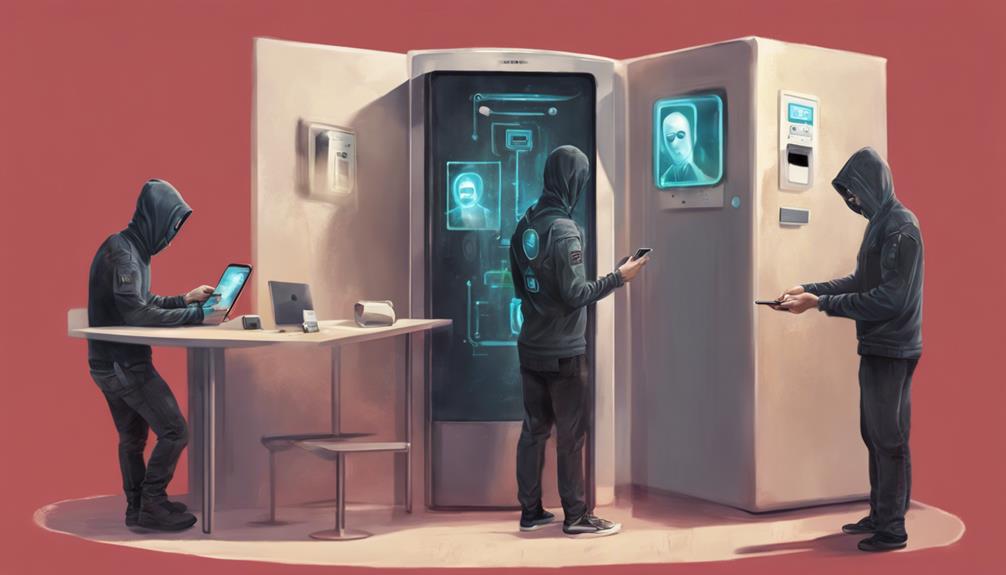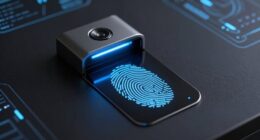While Blink cameras offer convenience, recent vulnerabilities identified by Tenable Inc pose risks. These vulnerabilities grant hackers full control and access to live footage, compromising privacy. Amazon has issued security updates to address these threats. Proactive measures like regular firmware updates and enabling two-factor authentication are essential to prevent unauthorized access and protect against potential breaches. Securing Wi-Fi networks, using strong passwords, and updating login credentials regularly are vital steps. Safeguarding against hacking requires a multi-layered approach. Implementing these security measures strengthens protection against potential threats.
Key Takeaways
- Regular firmware updates address vulnerabilities.
- Enable two-factor authentication for added security.
- Use unique login information for each device.
- Implement strong passwords and avoid sharing.
- Place cameras in secure, hard-to-reach locations.
Potential Security Risks With Blink Cameras
The potential security risks associated with Blink cameras highlight the importance of vigilance and proactive measures to safeguard users' privacy and data.
Tenable Inc recently identified 7 severe vulnerabilities in Blink XT2 camera systems, potentially granting attackers full control and access to live footage. These vulnerabilities could allow hackers to remotely view camera feeds, presenting a significant privacy and security threat to Blink camera users.
In response to this alarming discovery, Amazon, the owner of Blink, swiftly issued automatic security updates to address the identified vulnerabilities and protect impacted devices. This incident underscores the critical need for regular firmware updates and robust security measures to prevent unauthorized access to Blink cameras.
Implementing two-factor authentication, securing Wi-Fi networks, and placing cameras in secure locations are recommended steps that can help mitigate the risks of Blink cameras being hacked.
Users must remain vigilant and prioritize implementing security updates to safeguard the safety of their devices and personal information.
Understanding Hacking Methods for Blink Cameras

Recent findings by Tenable Inc have shed light on the various hacking methods that pose risks to Blink cameras. These include local and remote hacking techniques and exploiting security vulnerabilities. Understanding these methods is essential for users to identify signs of potential breaches, like unusual sounds or unauthorized password changes.
Common Hacking Risks
Numerous hacking methods pose significant risks to Blink cameras, exploiting vulnerabilities that could compromise security and privacy. Tenable Inc identified weaknesses in Blink cameras that hackers can exploit, potentially gaining access to live audio feeds and other connected smart devices.
These hacking methods encompass both local and remote attacks, taking advantage of security loopholes within the system. Signs of a hacked Blink camera may manifest through unusual sounds, decreased performance speed, or unauthorized password modifications.
To mitigate these risks, it is vital to implement proactive security measures. Regularly updating firmware is essential to patch any identified vulnerabilities. Additionally, employing unique login credentials and routinely updating login information can bolster the security of Blink cameras.
Moreover, enabling two-factor authentication, placing devices in secure locations, and ensuring strong Wi-Fi encryption are additional steps that can enhance the overall security posture of these security cameras.
Protecting Your Camera
Understanding the various hacking methods that can target Blink cameras is imperative for users looking to safeguard their devices against potential security breaches.
Blink cameras employ WPA2 Wi-Fi encryption and encrypted video footage to enhance security, yet hackers may still attempt local hacking, remote hacking, or exploit security vulnerabilities. Signs of a hacked Blink camera can manifest as unusual sounds, sluggish performance, or unauthorized password changes.
To fortify against such security risks, it is essential to regularly update the Blink camera firmware, utilize unique login credentials, and secure the Wi-Fi network. By comprehending how hackers might target Blink cameras, users can implement effective security measures to thwart unauthorized access, ensuring the protection of their privacy and data integrity.
Stay vigilant and proactive in managing the security of Blink cameras to mitigate the potential threats posed by malicious hacking attempts.
Signs of a Hacked Blink Camera

Indications of a compromised Blink camera include unusual sounds, sluggish performance, unauthorized password changes, suspicious activities, and any signs of unauthorized access or control.
Unusual sounds emitting from the Blink camera, such as static or voices, may suggest unauthorized access. If you notice sluggish performance, delayed video streaming, or sudden disconnections, it could be a sign of a hacked camera.
Unauthorized password changes without your action are red flags indicating a potential security breach. Watch out for any suspicious activities like unexplained camera movements or changes in settings, as these could be attempts by hackers to gain control.
Any signs of unauthorized access or control over your Blink camera should be investigated promptly to safeguard your security and privacy. Stay vigilant and act swiftly upon noticing these signs to protect your Blink camera from potential hacking threats.
Strengthening Blink Camera Security Measures

Enhancing the security of Blink cameras involves implementing proactive measures to mitigate potential vulnerabilities and safeguard against unauthorized access. Cyber security plays an essential role in protecting these devices from hacking attempts.
One of the recommended security practices is to enable two-factor authentication (2FA) for Blink camera accounts. By requiring a second form of verification in addition to the password, 2FA adds an extra layer of protection against unauthorized access.
In light of recent concerns raised by Tenable Inc regarding potential vulnerabilities in Blink cameras, it is vital for users to prioritize cyber security measures such as 2FA. This additional security step can help prevent unauthorized individuals from gaining access to live audio feeds or exploiting security weaknesses.
Importance of Firmware Updates for Blink Cameras

Regular firmware updates play a critical role in maintaining the security integrity of Blink cameras. These updates are essential for patching any potential security vulnerabilities that hackers may exploit to gain unauthorized access to the Blink system. Neglecting firmware updates could leave Blink cameras susceptible to hacking attempts, compromising the privacy and security of users.
Amazon, the parent company of Blink, has taken proactive measures by issuing automatic security updates for Blink cameras to promptly address any identified vulnerabilities. By keeping Blink cameras updated with the latest firmware releases, users can greatly reduce the risk of unauthorized access by hackers.
It is highly recommended that Blink camera owners regularly check for and install firmware updates to guarantee the highest level of security for their devices. Staying vigilant in applying these updates helps to strengthen the defenses of Blink cameras against potential cyber threats.
Implementing Unique Login Information for Blink Cameras

Implementing unique login information for Blink cameras is essential in safeguarding against potential security breaches.
Secure login credentials and password protection measures serve as key components in fortifying the safety of these devices.
Secure Login Credentials
To strengthen the security of Blink cameras, ensuring the use of distinct login credentials for each device is essential in safeguarding against potential unauthorized access. By implementing unique login information for every Blink camera account, the risk of hackers gaining access to multiple devices through a single compromised password is greatly reduced.
Additionally, utilizing strong, complex passwords adds an extra layer of security, making it harder for unauthorized individuals to breach the system. Avoiding the practice of sharing passwords further enhances security by maintaining the confidentiality of login credentials and minimizing the chances of unauthorized access.
Regularly changing passwords for Blink cameras is also important in deterring hackers and protecting the devices from potential security breaches. Moreover, incorporating two-factor authentication for Blink camera accounts provides an additional level of security by requiring extra verification beyond just a password.
Password Protection Measures
One fundamental measure for enhancing the security of Blink cameras is the implementation of distinct login credentials for each device, effectively mitigating the risk of unauthorized access by potential hackers.
By using strong and complex passwords unique to each camera account, users can greatly reduce the likelihood of hackers gaining access to their devices. Regularly updating these login credentials further bolsters security measures, making it harder for unauthorized individuals to breach the system.
Additionally, enabling two-factor authentication adds an extra layer of protection, requiring not only a password but also a secondary verification method to access the Blink camera accounts.
It is essential to avoid sharing Blink camera account passwords with others to maintain the security and integrity of the devices, as any compromise in login information could lead to unauthorized access and potential privacy breaches.
Enhancing Security With Two-Factor Authentication

Enhancing security with two-factor authentication greatly bolsters the protection of Blink cameras from potential unauthorized access. By requiring a second form of verification, two-factor authentication adds an extra layer of security to the cameras, reducing the risk of hackers gaining control and accessing sensitive footage.
This additional step is vital as it helps prevent unauthorized access even if the password is compromised. Users can easily enable two-factor authentication in the Blink app settings, making it a convenient yet highly effective security measure.
Implementing two-factor authentication is a proactive approach to safeguarding Blink cameras and ensuring the privacy and security of users' footage.
- Enhanced Protection: Two-factor authentication provides an additional barrier, making it significantly harder for hackers to breach the security of Blink cameras.
- Peace of Mind: Knowing that two-factor authentication is in place can give users a sense of reassurance that their cameras are well-protected.
- User-Friendly Security: Despite the advanced security it offers, enabling two-factor authentication is a user-friendly process within the Blink app settings.
Safeguarding Against Local Camera Hacking

Implementing robust security measures is essential for safeguarding Blink cameras against potential local hacking threats.
Blink cameras utilize Wpa2 Wi-Fi encryption and encrypted video footage to enhance home security and deter unauthorized access. It is important to note that local hacking of Blink cameras typically necessitates physical proximity to the device, reducing the risk compared to remote hacking.
Regularly updating the Blink camera firmware is vital in patching security vulnerabilities that local hackers may exploit, underscoring the importance of staying vigilant with software updates.
Placing Blink cameras in hard-to-access locations further bolsters protection against local hacking attempts, serving as an additional deterrent.
Preventing Remote Hacking of Blink Cameras

Protection against remote hacking of Blink cameras is paramount in maintaining the security and privacy of your smart home system. To prevent unauthorized access and potential breaches, consider the following measures:
- Regular Firmware Updates: Keeping your Blink cameras' firmware up to date is essential in addressing known security vulnerabilities and strengthening the system against remote hacking attempts.
- Enhanced Login Security: Updating login credentials frequently and using unique usernames and passwords for each account can help prevent unauthorized access to your Blink cameras and associated smart devices.
- Additional Security Measures: Implementing two-factor authentication adds an extra layer of protection, securing Wi-Fi networks reduces the risk of unauthorized access, and placing devices in hard-to-reach locations further deters remote hacking attempts.
Frequently Asked Questions
How Do You Know if Your Blink Camera Has Been Hacked?
To determine if a Blink camera has been hacked, monitor for unusual sounds or sluggish performance. Unauthorized password changes may indicate a breach. Regular firmware updates and unique login credentials for each account can enhance security against hacking attempts.
Can Someone Else Access My Blink Camera?
Unauthorized access to your Blink camera is a serious concern. Implementing robust security measures like two-factor authentication, timely firmware updates, and secure Wi-Fi networks is vital to prevent potential breaches. Amazon has issued security updates to address vulnerabilities.
Are Blink Cameras Secure?
Ensuring the security of Blink cameras involves proactive steps. While recent vulnerabilities posed risks, prompt updates from Amazon demonstrate commitment to enhancing security. Regular monitoring, timely updates, and strong passwords are key to bolstering Blink camera security against potential threats.
How Can You Tell if Someone Is Watching Your Blink Camera?
To detect potential unauthorized access to your Blink camera, monitor for unusual sounds or delays in video streaming, unexpected password changes, and review activity logs regularly. Employ two-factor authentication and guarantee firmware updates for enhanced security.
Conclusion
In summary, ensuring the security of Blink cameras is essential in protecting personal privacy and preventing unauthorized access. By implementing strong security measures such as firmware updates, unique login information, and two-factor authentication, users can safeguard against potential hacking threats.
Think of Blink cameras as a fortress, where each layer of defense adds another level of protection against intruders. Stay vigilant and proactive in maintaining the security of your Blink cameras to mitigate the risk of unauthorized access.









